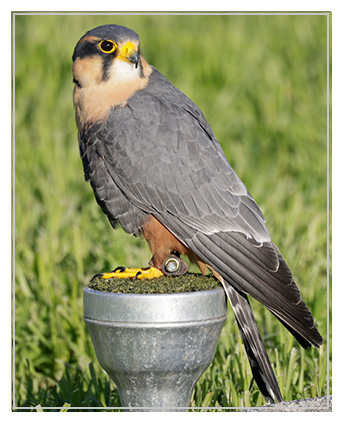 The Aplomado Falcon (Falco rusticolus) is very slender, long-winged, and long-tailed, the size of a small peregrine falcon (F. peregrinus), at 12 - 16 in long and with an average wingspan of about 36 in, but only half the weight, at about 7.3–10.8 oz in males and 9.6 - 16 oz in females. In adult birds, the upperparts are dark blue-grey, as is much of the head, with the usual falcon "mustache" contrasting sharply with the white throat and eyestripe. The upper breast continues the white of the throat; there are black patches on each side of the lower breast that meet in the middle; the belly and thighs, below the black patches, are light cinnamon. The tail is black with narrow white or grey bars and a white tip. The cere, eye-ring, and feet are yellow or yellow-orange.
The Aplomado Falcon (Falco rusticolus) is very slender, long-winged, and long-tailed, the size of a small peregrine falcon (F. peregrinus), at 12 - 16 in long and with an average wingspan of about 36 in, but only half the weight, at about 7.3–10.8 oz in males and 9.6 - 16 oz in females. In adult birds, the upperparts are dark blue-grey, as is much of the head, with the usual falcon "mustache" contrasting sharply with the white throat and eyestripe. The upper breast continues the white of the throat; there are black patches on each side of the lower breast that meet in the middle; the belly and thighs, below the black patches, are light cinnamon. The tail is black with narrow white or grey bars and a white tip. The cere, eye-ring, and feet are yellow or yellow-orange.
Except that females are bigger than males, the sexes are similar. Juvenile birds are very similar to adults, but their upperparts and belly band are blackish brown, the chest is streaked with black, the white on the head and breast is buffy, and the cinnamon on the underparts is paler, as are the feet.
This species may be confused with the bat falcon (F. rufigularis) and the orange-breasted falcon (F. deiroleucus), which have similar white-black-rust patterns below, but those species are built more like peregrine falcons and have solidly blackish heads and darker rufous bellies.[4] These two species are generally considered to belong to the same lineage as the aplomado falcon. Two other Falco species of the Americas, merlin (F. columbarius) and American kestrel (F. sparverius), seem to be closer to the Aplomado group than most other falcons, but the relationships of all these lineages are fairly enigmatic. All that can be said with some certainty is that they diverged as part of an apparently largely western Holarctic radiation in the Late Miocene, probably around 8 to 5 million years ago.
